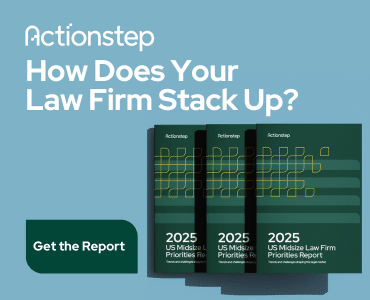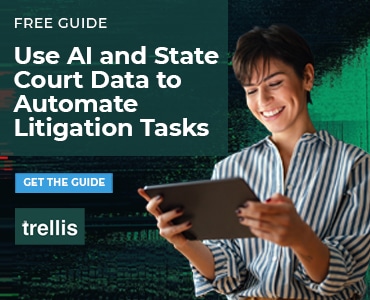The new identity crisis for law firms isn’t philosophical; it’s digital. Here are five key areas where firms should focus their efforts to reduce identity risk, protect data and avoid litigation.
Table of contents
Unmanaged AI and SaaS Equal a Minefield of Compliance Risks
The new identity crisis for law firms isn’t philosophical; it’s digital. A recent survey by CloudGate.ai of 1,000 CIOs and CISOs reveals a concerning trend: Over 60% of enterprise SaaS and AI applications lack governance. That’s not just an IT oversight — it’s a legal risk waiting to be exploited.
This revelation demonstrates that most organizations are losing track of who has access to what, when and why. The result? Excessive permissions, orphaned accounts, and unsanctioned artificial intelligence tools operating in the shadows — all of which create a minefield of regulatory and litigation exposure.
The findings are shocking:
- Nearly half of former employees still have access to internal systems.
- One in two users has more access than they need.
- Just 15% of companies have implemented just-in-time (JIT) access.
- Only 5% follow an accurate least-privilege model, despite the well-known benefits.
When identity management fails, the consequences ripple far beyond the IT department. In a data breach litigation, discovery will quickly reveal whether appropriate controls were in place. Regulators will ask why terminated employees were still able to download sensitive data. Opposing counsel will scrutinize whether an unsanctioned AI integration accessed privileged or confidential information.
Implications for Attorneys and Their Clients
If your clients operate in regulated sectors — such as finance, health care, legal or government — unmonitored access to systems and data poses a compliance nightmare. Identity governance failures can lead to multiple problems:
- Violations of HIPAA, the Gramm-Leach Bliley Act (GLBA) and GDPR.
- Breach of contract or fiduciary duties.
- Evidence of negligence in cybersecurity litigation.
- Erosion of attorney-client privilege through careless AI adoption.
The most alarming part? The risk is already widespread, and most organizations don’t realize how exposed they are until it’s too late.
Practical Steps Law Firms Should Take to Reduce Identity Risk
Law firms must examine their internal identity and access management (IAM) practices. Given the sensitivity of their data, firms cannot afford to rely on outdated or informal controls. With increasing regulatory scrutiny and the rise of insider threats, it’s critical for firms to proactively secure who has access to what and when.
Here are five key areas where firms should focus their efforts.
1. Automate Access Controls
Modern identity governance solutions can automate provisioning, deprovisioning and access reviews in real time.
2. Enforce Least Privilege and JIT Access
Implementing time-limited or contextual permissions reduces both human error and the attack surface.
3. Audit Internal Policies and Documentation
Review onboarding, offboarding and access review procedures for consistency and legal defensibility.
4. Update Contracts and Vendor Agreements
Ensure third-party agreements include access controls, monitoring obligations and breach notification clauses.
5. Encourage Legal–IT Collaboration
Legal and IT leaders must collaborate on risk assessments, breach response plans, and governance structures.
The Legal Stakes Are Rising
Unchecked access and shadow IT are symptoms of a deeper governance issue. And in today’s AI-enabled business world, they’re also liabilities. When breaches occur, the questions are not all technical:
- Who had access?
- Why didn’t access get revoked?
- Was sensitive data protected by policy, or exposed by oversight?
These are legal questions. And in many cases, courts and regulators will not be sympathetic to “we didn’t know.”
Organizations have long viewed Identity management as an IT administrator’s responsibility. But as AI tools proliferate and compliance burdens grow, identity governance must become a legal priority. For law firms, this is an opportunity to step in proactively. Understand that effective IAM is not just good hygiene — it’s a vital risk management strategy. Law firms must treat excessive permissions and orphaned accounts as material threats, not mere technical glitches.
Michael C. Maschke is President and Chief Executive Officer of Sensei Enterprises, Inc. He is an EnCase Certified Examiner (EnCE), a Certified Computer Examiner (CCE #744), an AccessData Certified Examiner (ACE), a Certified Ethical Hacker (CEH) and a Certified Information Systems Security Professional (CISSP). He is a frequent speaker on IT, cybersecurity and digital forensics, and he has co-authored 14 books published by the American Bar Association. mmaschke@senseient.com.
Sharon D. Nelson is the co-founder of and a consultant to Sensei Enterprises. She is a past president of the Virginia State Bar, the Fairfax Bar Association and the Fairfax Law Foundation. She is a co-author of 18 books published by the ABA. snelson@senseient.com
John W. Simek is the co-founder of and a consultant to Sensei Enterprises. He holds multiple technical certifications and is a nationally known digital forensics expert. He is a co-author of 18 books published by the American Bar Association. jsimek@senseient.com
More Cybersecurity Tips:
- Updates from the Breach: A Primer on Cybersecurity Prevention and Response
- Ransomware Today: Top Tips for Law Firms (Get these 14 things done and you’re way ahead of most of your colleagues)
- Cybersecurity Trends: 25% of Law Firms Have Been Breached
- Shadow IT: A Serious Threat to Law Firms
Subscribe to Attorney at Work
Get really good ideas every day for your law practice: Subscribe to the Daily Dispatch (it’s free). Follow us on Twitter @attnyatwork.
Illustration ©iStockPhoto.com















